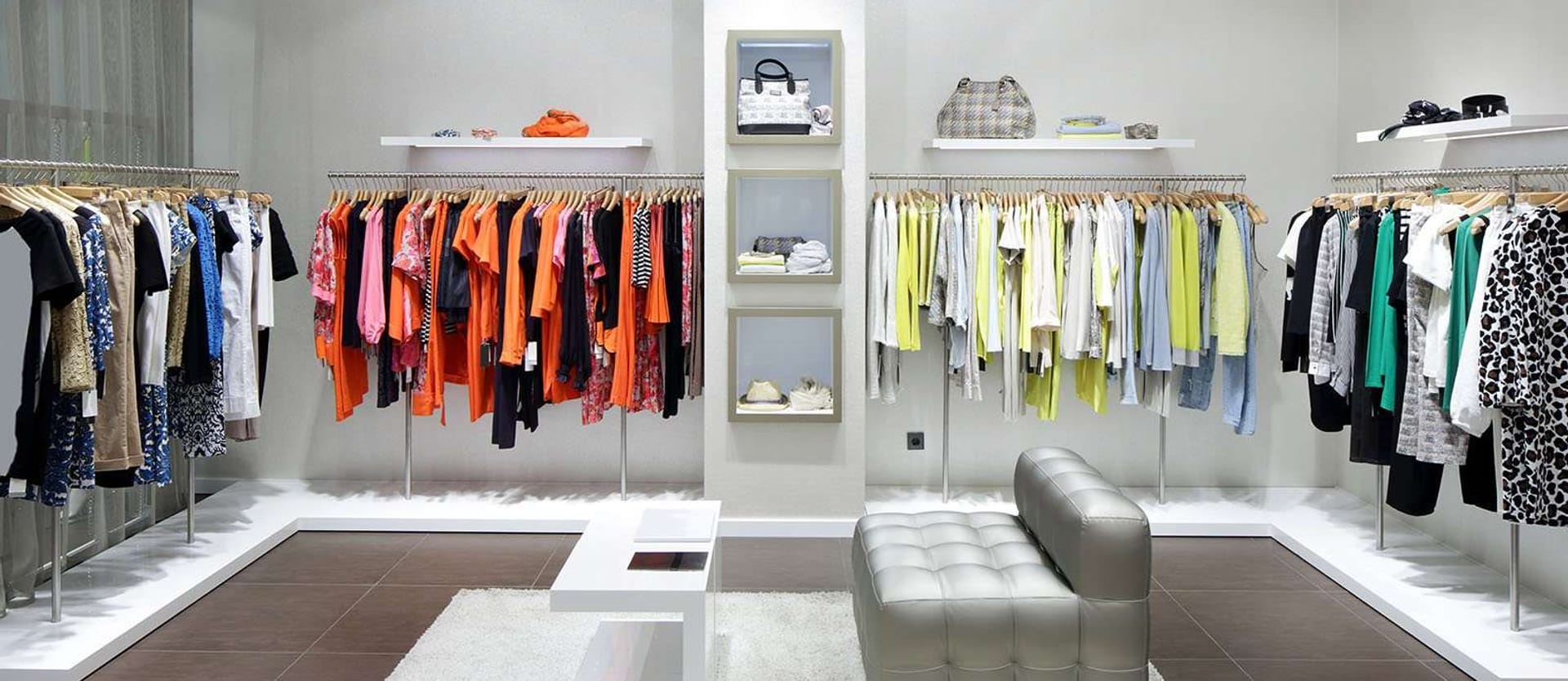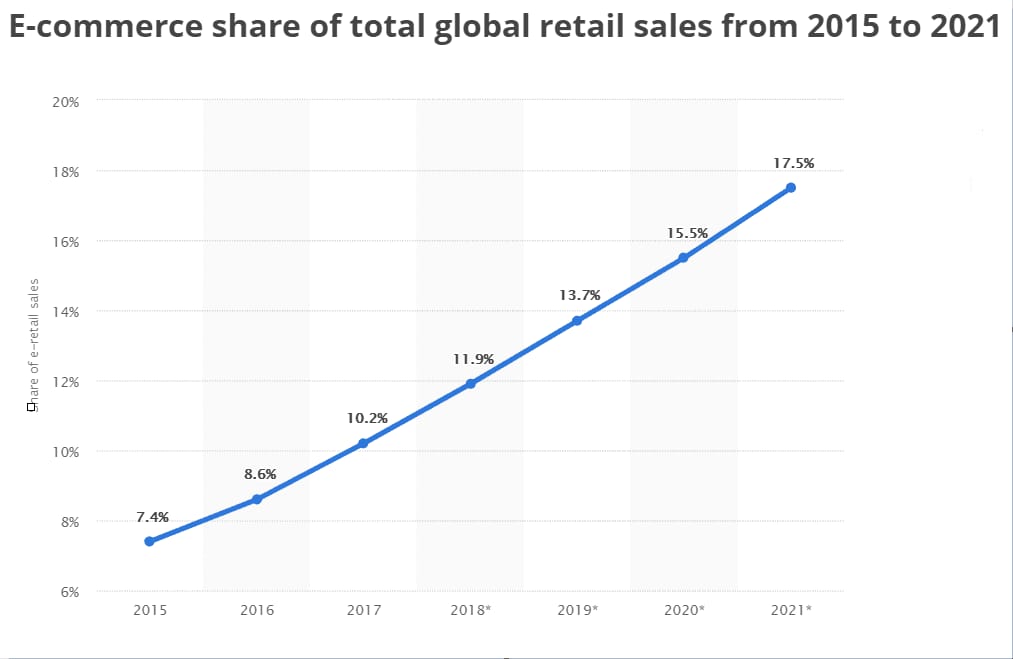
eCommerce share of total retail sales worldwide from 2015 to 2021. Source: Statista
Physical stores still have the lion's share of sales, but the growing demand for online experiences shouldn’t be ignored. To remain competitive, retailers must allow in-store customers to enjoy the benefits of online shopping. Fast checkout, personalized recommendations, or instant access to customer care at any time are a few services that can be implemented with the help of artificial intelligence.For this article, we discussed current and potential applications of AI in retail, as well as the state of the industry in general, including factors that drive adoption of cognitive technologies. Experts from such companies as Lucidworks, Advantech, KAPUA, MindsDB, Fellow Robots, KaizenTek, Aware Corporation, XR Web, and fashion brands Hockerty and Sumissura joined the discussion.
Let’s find out how retailers invest in high tech to impress customers in physical stores and use tools to increase the efficiency and speed of their operations.
Cashierless shopping: Amazon Go, JD, Alibaba, and Lenovo
Grocery shopping continues its evolution from being social and interactive to choosing items and checking out with little to no contact with the store staff.Customers used to chat with a counter clerk who knew the products and assembled orders. That was the only way to shop. But a new wrinkle was added with the introduction of self-serve grocery stores. The first US store of this kind – Piggly Wiggly – opened in 1916 in Memphis, Tennessee.
Self-checkout kiosks, designed and patented in the 1990s, became a popular alternative to cashier lanes in the early 2000s. Retailers aimed to free customers from wasting time in long checkout lines, letting them scan and pay themselves. Such an initiative was one of the answers to growing customer demand for a smooth shopping experience as well as being responsive to competition in the industry.
Forrester Consulting discovered that poor checkout experience and long lines are the third highest reason shoppers would skip the line and shop in a different place.
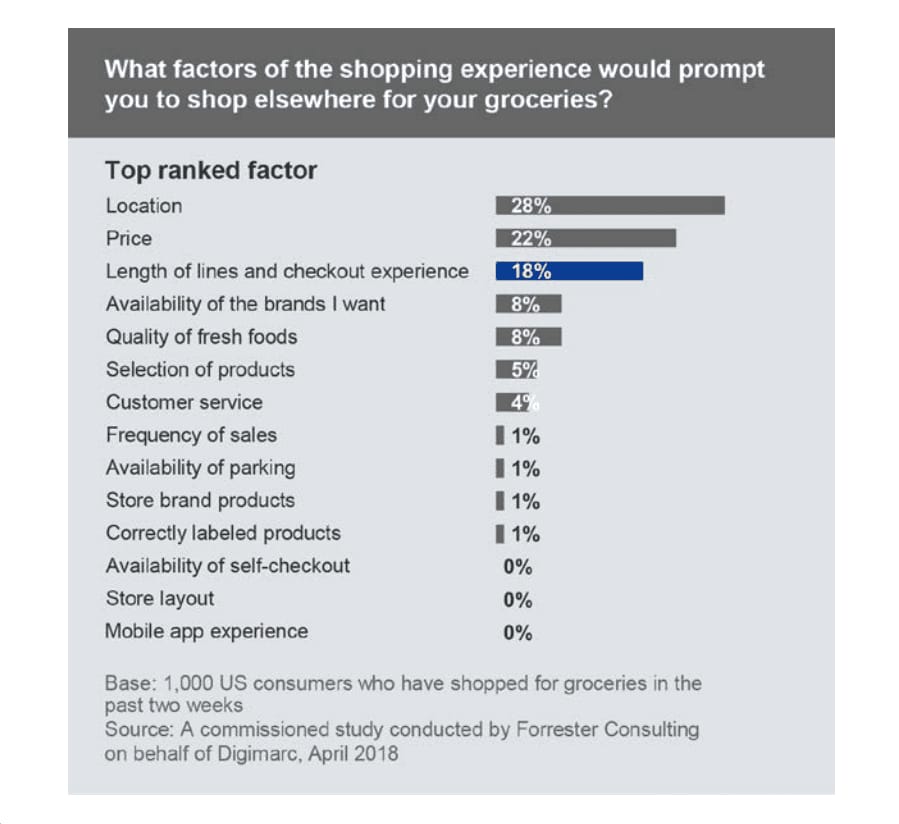
Slow checkout is the reason that 18 percent of customers would shop elsewhere. Source: Forrester Consulting
Further transformation of checkout in the name of speed and convenience is possible though the use of AI.Amazon Go stores. In December 2016, Amazon introduced the "Just Walk Out" shopping experience with the first Amazon Go store in its Seattle office building.
A visitor armed with an opened Amazon Go app scans a QR code on a turnstile to enter a store (like at an airport to board the plane) and picks up what they need. In-store cameras and sensors detect each product taken from a shelf, as items are being added to a virtual cart while the customer proceeds. “If you change your mind about that cupcake, just put it back ̶ our technology will update your virtual cart automatically,” explains the official video. A shopper can walk out once they’re done shopping, and their Amazon accounts will be charged automatically shortly after the visit.
“Our checkout-free shopping experience is made possible by the same types of technologies used in self-driving cars: computer vision, sensor fusion, and deep learning,” the representatives note on the website.
Amazon Go experience. Source: Amazon
After being in a test mode for a bit more than two years, the cashierless store became available to the public in January 2018. To date, 12 Amazon Go cashierless convenience stores are open in Seattle, Chicago, San Francisco, and New York. The company is considering opening 3000 convenience stores by 2021.However, the cashierless store concept has been under pressure in the US due to a backlash against cashless systems. Critics emphasize that cashless operations discriminate against customers without bank accounts and may undermine privacy and data security. The Federal Deposit Insurance Corporation in their 2017 survey estimated that 6.5 percent of U.S. households (20,5 million people) didn’t have a checking or savings account.
Philadelphia, New Jersey, San Francisco have already approved bans on cashless brick-and-mortar stores. New York City, Chicago, and Washington D.C. have also introduced similar legislation.
Amazon, in turn, is enabling cash payments in its stores (though this measure negates the idea of the seamless shopping experience). The NYC store that opened on May 7 accepts cash.
The Seattle-based company isn’t the only one working on checkout-free shopping. Let’s travel overseas and look at how Chinese tech giants have been developing in the same field.
JD.com’s chain of unmanned stores. China's second largest online retailer JD.com is one of the companies making checkoutless shopping a reality. In October 2017, the company started testing two unmanned stores in its Beijing headquarters. The JD stores use RFID (radio frequency identification), facial recognition, and image recognition technology to monitor retail activity. For instance, in-store cameras “recognize customers’ movement and generate heat maps of the activity to monitor traffic flow, product selection, and customer preferences, helping store owners to stock efficiently.”
One of the largest (2,648 square foot) JD cashierless stores opened in May 2018 in Xiongan New Area aka the city of the future. That’s a new district outside Beijing, which the government plans to turn into a special economic area. Like in Amazon Go, a customer scans a QR code at the turnstile to enter the store. The only difference is that they take a selfie with a mini program on WeChat to generate it, and a camera checks whether the face matches the code.
Once a person is done shopping, they walk through a billing tunnel to pay. A sensor reads data from items’ RFID chips to make a virtual check. A camera identifies the shopper – and their payment account is charged. Checkout is said to take about 20 seconds.

Checkout in a billing tunnel in one of the JD stores. Source: Abacus
In August 2018, the company launched its first convenience store abroad in Jakarta, Indonesia.The JD.ID X-Mart visitors can choose from a wide range of items, including beauty products and fast-moving consumer goods, as well as fashion and apparel.
Shopping at JD.ID X-Mart. Source: JD.com, Inc.
Souvenirs, wine, coffee, and snacks at Alibaba stores. Alibaba, China’s leading eCommerce company, sells branded merchandize in Futuremart, its cashierless store (opened in April 2018 at its Hangzhou headquarters.) Wine lovers can check out the cashierless store, its concept introduced previously at Vinexpo Hong Kong. In 2017, the eCommerce heavyweight created a buzz with its pop-up Tao Cafe.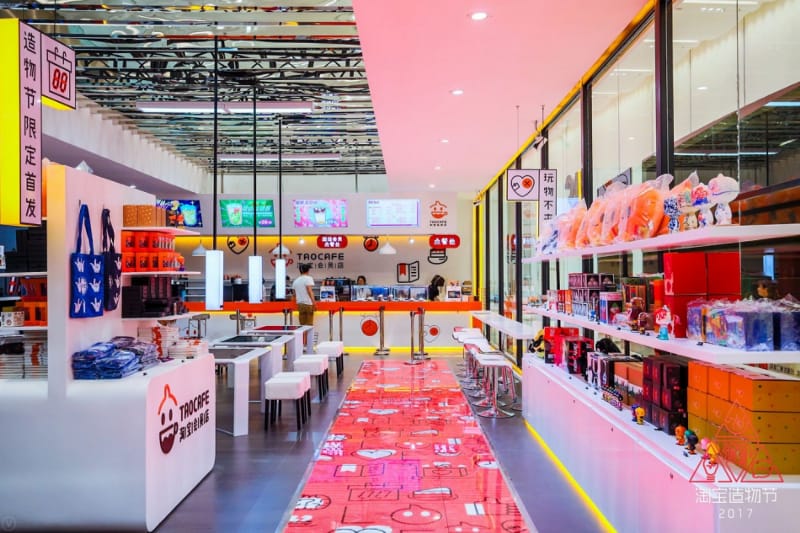
Waiters and baristas but no cashiers are working at Tao Cafe. Source: RetailWeek
Lenovo Lecoo Unmanned Store. Although we talked about two Chinese companies, there are more companies opening cashierless stores in the country. For instance, Lenovo opened a convenience store in Beijing in 2018. Facial recognition technology is used to let customers in and identify their account profiles: Shoppers wave to a tablet at the entrance.
A customer looks at a tablet to get into the Lenovo store. Source: Lenovo StoryHub
Forecasting demand with machine learning in Walmart
When walking around any store, small or large, you expect to find what you came in for. Consumers take product availability for granted, but it takes a lot of effort for retailers to optimally stock their stores. It’s crucial for businesses to be able to precisely anticipate demand for products. Let’s also keep in mind that a large store may have tens of thousands of stock-keeping units and some items are often bought together. Buy-online-ship-to-store orders, which more and more shoppers like, must be considered.

Check our video on demand forecasting
Companies need to become more efficient in handling working capital and managing inventory amidst the dynamics of business operations and changes in consumer behavior, thinks Sebastian Jungels, co-founder of KAPUA. “If you know what products you are selling to which customers or in which regions and when you will be selling them, you can lower your working capital since you won’t need to hold that much product in stock. Additionally, you can increase your revenue because you have the right product, in the right quantities, at the right time, that way decreasing your out-of-stock scenarios.”The use of ML-powered analytics solutions can help businesses forecast inventory demand with high accuracy. Systems that rely on machine learning are capable of analyzing a multitude of data points, finding subtle patterns (indicating changes in customer preferences, behavior, or satisfaction), which can be non-obvious to humans. What’s more, these systems don’t require explicit programming as machine learning models learn from data. The more data is fed to them, the better they handle it while deriving meaningful insights.
Speaking about their analytics platform, Sebastian highlights several technical conditions that must be met to ensure that an off-the-shelf solution provides accurate forecasting results:
- the best performing model is defined;
- the model is automatically retrained to remain current;
- combined internal (organizational data like orders, opportunities, and financial data) and external (trend/market data, GDP information, oil prices, weather data, etc.) data is analyzed.
Walmart uses ML-based systems to forecast demand for its enormous product list. In March, the director of data science for Walmart Labs John Bowman told about their new demand forecasting solution at Nvidia’s GPU Technology Conference.
The demand forecasting model that runs on Nvidia GPUs (graphical processing units) achieved 1.7 percent higher prediction accuracy compared to the existing system. GPUs provide immense computational power, so systems that run on such hardware can efficiently analyze vast amounts of data and generate more accurate forecasting results.
The current system was developed by JDA Software and does 80 percent of the forecasting work: It generates demand forecasts with a full 52-week horizon every week for about 500 million item-by-store combinations in the US.
The GPU-based model consists of an ensemble of multiple machine learning algorithms. These algorithms run together and sum up their estimates to predict a target variable more accurately. The model forecasts demand for every product category using about 350 data features (problem properties). Features include historical sales (from the last few weeks and the same time period last year), information about promotions like the Super Bowl or Supplemental Nutrition Assistance Program (SNAP) data.
John Bowman shared plans to use this system for 100 percent of forecasting work by the end of 2019.
In-store inventory management with robots at Lowe's and Walmart
Despite the ease and convenience of online shopping, brick-and-mortar stores are still the thing. The 2017 Generational Perspective report by Alliance Data suggests that 75 percent of customers still want to see a product in-store before they buy it. And it would be a pity to lose a customer because a product was out of stock. According to the study by IHL Group, more than 24 percent of Amazon’s retail revenue comes from consumers that first tried to buy the product at their local stores.Out-of-stocks may not only lead to revenue losses but also to reputation damage. “On-shelf product availability is extremely important for retailers in a world where consumers can leave a bad review or share negative content on social media, including photos of empty shelving, and generally express their dissatisfaction to others in real time,” notes artificial intelligance engineer of Fellow Robots Jagadish Mahendran.
Oversupply is also a problem, especially for perishable goods like dairy, meat, or cut flowers. Other issues that may leave customers dissatisfied with the service are pricing errors and misplaced items.
Retail inventory management can be automated with robotics and AI, adds Jagadish.
NAVii in-store robot for inventory control. NAVii is one of the Fellow’s products developed for this purpose: “NAVii is an AI-powered fully autonomous robot which scans aisles in a store providing near-real-time detection of price errors and of out-of-stocks,” says the expert. Employees use mobile devices with the Fellow app to get alerts about detected issues, i.e., pictures or missing items with their exact location.
Data collected from the robot is processed in a cloud for compliance with the planogram, a diagram that shows how and where products must be placed to get maximum sales. Using this information, associates can ensure that shelves are stocked according to the planogram and fix mistakes. “Additionally, a virtual daily view of the store is provided in the cloud services layer of StoreView [the store map service]. When the robot isn’t monitoring inventory, it can help customers find the products they need,” adds Jagadish Mahendran.
Customer service is an additional purpose of LoweBot – the robot designed by Fellow Robots for Lowe’s Stores in the San Francisco Bay area, which the retailer introduced in 2016.
That’s how LoweBot helps shoppers
The LoweBot recognizes shoppers using 3D scanning, greets them, and helps customers navigate the store to find an item of interest – laser sensors allow it to accurately measure distances to objects. It also can answer basic questions in multiple languages using speech recognition. People can talk to the robot or type the needed item on a touch screen.Shelf-scanning robot at Walmart locations. Walmart is also using an in-store robot by Bossa Nova Robotics to augment human work. The autonomous shelf-scanning robot reports to employees on pricing errors, out-of-stocks, or misplaced products in real time.
The interview with Bossa Nova co-founder and CTO Sarjoun Skaff and Brian Heater of TechCrunch
In April, the retailer announced its plans to use 300 more robots in its stores, increasing their total number to 350.Chatbots to improve and personalize in-store and online experiences: Burberry and Mall of America
If you needed to describe modern customer mentality with song lyrics, that would be Queen singing, “I want it all, and I want it now.” The opportunity to quickly find a product, get basic information (i.e., availability, shipping rules) on it, or learn about terms of service to decide on a purchase are the musts of customer experience not the nice-to-haves.“Having a huge team of customer-facing agents with the ability to interact on the fly is not sustainable or scalable. So there needs to be a way to connect with customers in an efficient manner,” notes chief communications officer at XR Web James Scholz.
Chatbots can serve as a backup for customer service representatives in this case.
“The current trend [for AI use cases in retail] is providing chatbots or virtual assistants on websites to allow customers to quickly find the info they want. And this trend is slowly expanding to cover phone and email support as well,” continues James.
According to the 2018 State of Chatbots research, customers mention 24-hour service (64 percent), the ability to get instant responses to inquiries (55 percent) and answers to simple questions (55 percent) among potential benefits of chatbots.
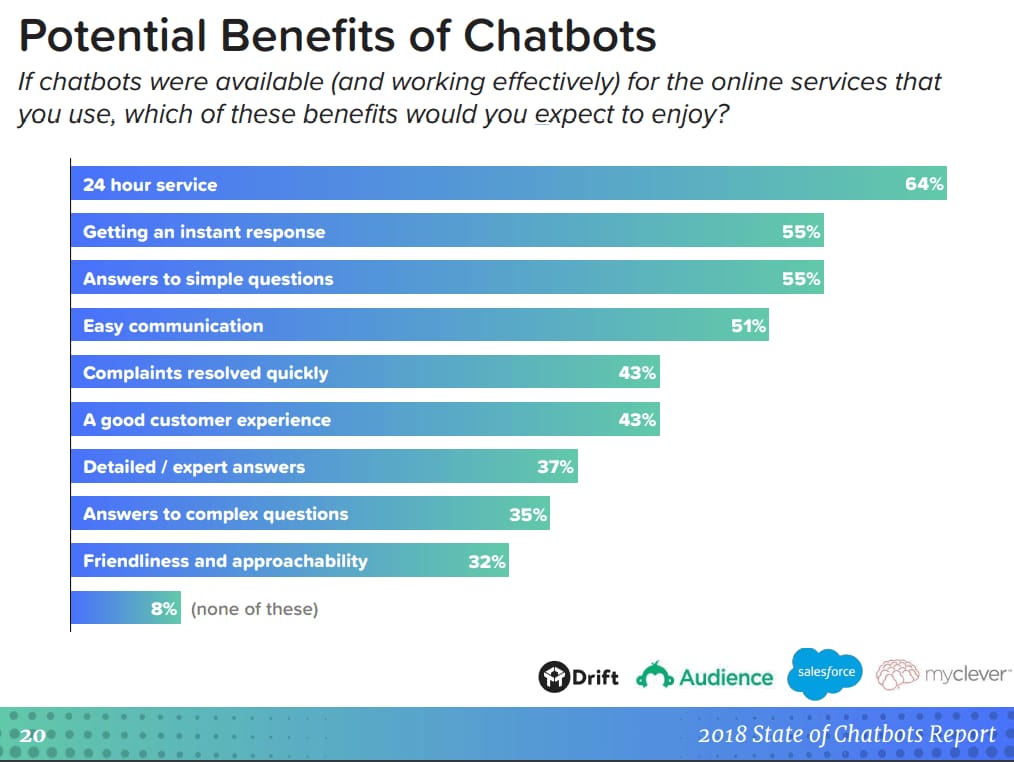
Possible benefits of chatbots according to customers. Source: The 2018 State of Chatbots Report
Let’s see how retailers engage with customers through virtual assistants, improving both in-store and online experiences.Burberry chatbot. Burberry was among the first fashion brands to use Facebook bots. In 2016, the British luxury brand launched the chatbot for London Fashion Week to allow customers to check out apparel from the new collection, learn about the collection itself, and watch a fashion show that was being held at Makers House.
The chatbot is active. Facebook users can read more about upcoming collections by subscribing to email updates, browse new clothes with pricing info, learn about shops nearby based on their current location, and book an Uber ride to the nearest store. When pressing the “shop now” button, users are redirected to the website. The standard option to start a chat with a human customer representative is included as well.

The chatbot provides information about items and allows for connecting with customer support
Location-based chatbot at MOA. In 2017, the largest US mall – Mall of America – introduced the location-based AI chatbot to help customers navigate across more than 520 stores, 60 restaurants, and other entertainment areas. The chatbot, built in collaboration with Satisfi Labs, is available on the mall’s website, Facebook page, and mobile app. Developers also thought about shoppers that prefer talking with Amazon Alexa.The assistant helps customers find stores, places to eat, answers complex questions on current deals, events, or services based on their location. Shoppers can request live assistance if they need additional information.

The Mall of America bot at work
Visual search: Scan + Shop for Urban Outfitters customers and Style Match feature on the ASOS app
When you can’t find the right words to describe that awesome dress a blogger showed off on Instagram but want to buy a similar one, visual search can help you. Make a screenshot, upload an image to a visual search tool or app, browse suggested outfit options, and choose the one that fits your style and budget.Visual search allows retailers to overcome barriers around language or potential brand stereotypes, thinks James Scholz of XR Web. Customers, in turn, can access a wider range of products. “If a user is looking for a red jacket, they'll see all the red jackets that may be relevant to them. Even the ones in stores they might not typically consider.”
Visual search engines use artificial neural networks (ANN) – computing systems with architecture inspired by the way human brains work. Artificial neural networks consist of numerous interconnected processing elements called neurons, hence the name. Image recognition is one of the tasks neural networks perform well. ANNs analyze images uploaded by users and generate image descriptions (tags), for instance, type of clothes, fabric, color. Image descriptions are compared to a list of items that stores provide together with their corresponding tags. Search results are then ranked and presented according to a similarity score.
Customers find the technology useful: 61.7 percent of millennials aged 18-20 and 62.2 percent of older millennials (21-43) said they want visual search to be a part of their shopping experience, according to the study ViSenze visual-search-tolls provider conducted in 2018.
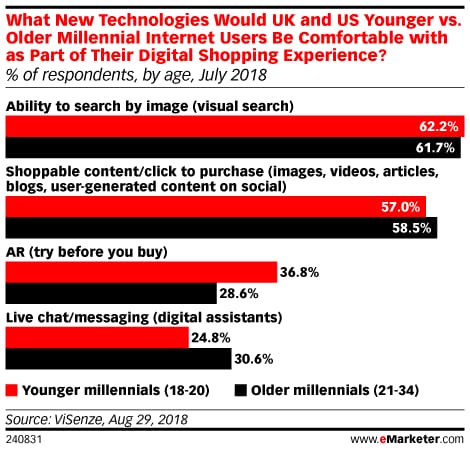
Millennials’ preferences regarding visual search. Picture source: eMarketer
So, retailers and brands implement it to ensure that each customer gets personalized service regardless of the channel used.Visual search feature on Urban Outfitters app. Urban Outfitters teamed up with Slyce to add Scan + Shop feature to its app. Customers can make a photo of any item from in-store advertising, catalog, or editorial and get information about it, as well as purchase a garment right away.

The app provides information about item price, availability, and other details. Source: Slyce
The feature, powered by 2D image recognition, simplified product discovery and enabled seamless interaction with customers across platforms. As a result, Urban Outfitters managed to increase in-store and online transactions.Search for similar looks for ASOS customers. Style Match visual search tool in the lets customers search for similar looks they find on social media, at stores or fashion events, but at a more affordable price. A screenshot, photo from a printed magazine of the app, can be used as search inputs.

Similar look suggestions by ASOS with Style Match. Source: Getty Images/ASOS
The eCommerce company first added the feature to its iOS app in August 2017 and rolled it out across all markets and devices in March 2018. The ASOS catalogue contains about 85,000 products with 5,000 new items being added every week.Voice activation: shopping with virtual assistants and Theatro, a tool for retail clerks
Voice product search and purchase. Customers are developing a new habit – searching for products online through virtual assistants like Amazon Alexa, Google Assistant, or Apple’s Siri.The smart speaker market has grown significantly, from 21.5 percent of US consumers in 2017 to nearly 41 percent in 2018. Voicebot.AI provides slightly bigger adoption numbers discovering that the percent of US adult smart speaker users grew from 47.3 million to 66.4 million during 2018.
Voice-enabled shopping is the least frequent use case for smart speakers, which accounts for 15 percent of monthly active users in 2018. However, the number of people who use these devices for shopping on a monthly basis grew from 13.6 percent during last year.
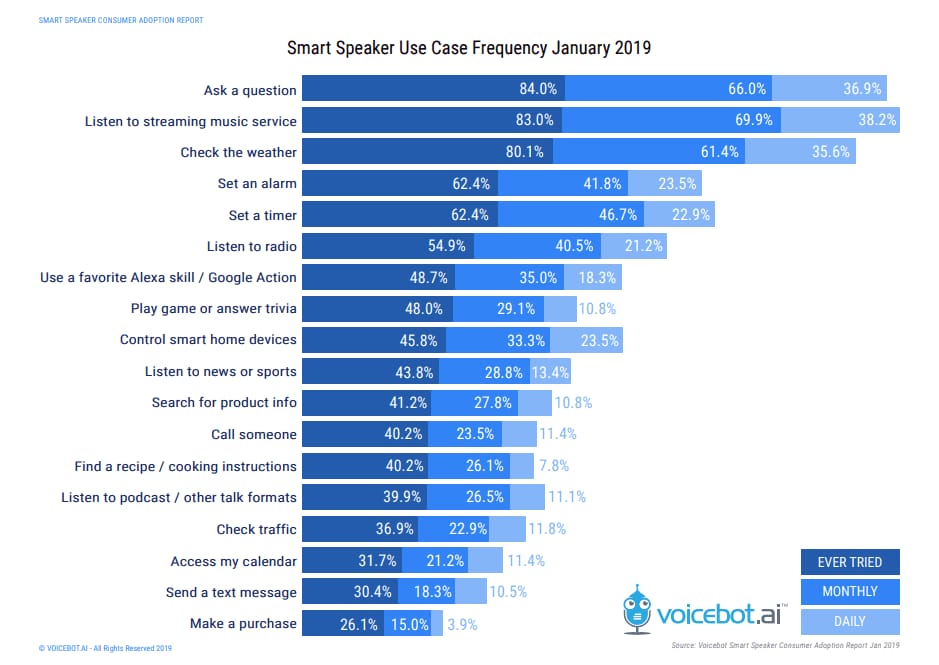
In January 2019, only 15 percent of smart speaker owners used them for monthly shopping. Source: The US Smart Speaker Consumer Adoption Report 2019
Retailers consider usage of voice-controlled devices and partner with virtual assistant providers.Amazon Alexa users can order goods at such stores as electronics retailer Best Buy, grocer Whole Foods (acquired by Amazon in August 2017), or online grocery brand Peapod.
Google has partnered with Kroger, Target, and Walmart to enable voice-activated shopping via Google Assistant. Walmart, unlike the other two retailers, doesn’t use the Google Express shopping service to process orders.
eMarketer estimated that voice shopping via smart speakers represented 0.4 percent of all US online sales in 2018, which is $2.1 billion. Nevertheless, OC&C Strategy Consultants expects that voice shopping sales will skyrocket to $40 billion in 2022.
The solution for store employees. Not only customers but store associates can benefit from voice activation. Theatro provides small, voice-controlled computers with built-in virtual assistants to communicate with each other, access information about inventory, or in-store services.
Theatro helps store associates easily interact with each other. Source: Theatro
Facial recognition for better customer experience and crime prevention: CaliBurger and solution by Hikvision
Facial recognition not only enables checkout in new generation stores but also allows for solving operational issues and customize experiences.Data sourced from facial recognition-powered tools can be valuable for in-store personalization.
Tailored in-store experience at CaliBurger. CaliBurger has self-ordering kiosks that use facial recognition software to identify existing customers, access their loyalty program information, and order history to recommend meals, and streamline ordering. The company started testing the technology at the end of 2017 at its Pasadena restaurant and plans to roll out the technology worldwide in the next 12 months.
Promotional video of self-service kiosks
“These technologies… allow us to see our customer in the offline world like Amazon sees its customer in the online world. And that allows us to create tailored experiences for the customer and also allows us to directly target that customer in new ways when they come back to the restaurants,” said Cali Group CEO John Miller in the interview to NEC America.HikVision solution for multiple purposes. Store assistants can also use facial recognition software to personalize interaction with customers. “We are currently working with a suite of AI-backed digital surveillance equipment that’s using facial recognition software to tailor customer experiences with “VIP Precision Marketing” – essentially identifying previous customers, setting up alerts and giving employees the opportunity to tailor retail experiences for them. It can be paired to a CRM database which provides a customer name, personal information like past purchases, etc.,” tells Sean Allan, digital marketing manager at Aware Corporation. The solution is purchasable through Hikvision video surveillance equipment provider and manageable via the HikCentral platform. It can be hosted on-premise or off-premise.
Surveillance systems provide real-time insights on customer navigation and activity that may allow for supply chain and store layout optimization. Sean Allan from Aware Corporation adds that their solution can be further used to identify high-traffic store areas via heatmap tracking and better optimize store layout for increased revenues. Queue detection is another use case for the surveillance system. Knowing in which departments customers spend the most time, management can take appropriate measures, for instance, assign more employees or even redesign the area.
Security and loss prevention are other use cases for the technology. In 2018, the National Retail Federation estimated that organized retail crime costs businesses $777,877 per $1 billion dollars in sales. What about those who shop without paying a dime? FaceFirst facial recognition solution provider discovered that 60 percent of known shoplifters were detected walking in at least two separate locations of the same retail chain, while 20 percent entered three or more locations.
Surveillance cameras with face recognition software match customers with individuals from retail crime databases as they walk into the store, allowing security guards to detain criminals right away.
Sewing facilities with computer vision and machine learning: Hockerty and Sumissura
AI and ML-based software may power equipment not only on sales floors but also in production areas. Brands of tailor-made clothing for men and women Hockerty and Sumissura don’t have physical studios or showrooms to experiment with high tech. However, they use ML- and AI-based systems to maintain high quality in the clothes they sew.eCommerce and innovation manager at Hockerty and Sumissura Alberto Gil tells about the Measurements Prediction system that currently uses machine learning models: “As we have more than 200,000 customers, and we know all their measurements, we can create AI models that forecast customer measurements based on their height/weight and body shape.” If predicted and provided measurements aren’t the same, employees may correct them, or customer support may reach out to a person to double check entered info.
“We deployed the first version almost eight years ago. Previously we were feeding the model nearly every six months to make it more precise. Since the last year, we’ve been using the machine learning model which doesn't need to be "updated" once in a while as it gets better and better every day,” notes Alberto.
Another system, Quality Control, is designed to ensure sewing workshop employees tailor garments right. It uses computer vision to check item measurements. “The system, built ad-hoc in our facilities, takes pictures of garments, measures them, identifies style and fabric, and then matches them with the specific order a customer placed. If there are any differences, the order is stopped, and the garment is sent for further inspection,” the representative explains.
The brand partnered with the Computer Vision Center at UAB (Universitat Autònoma de Barcelona/Autonomous University of Barcelona) to develop both systems although the first project was a specific request since it required “just math.”
Challenges in the retail industry
The use cases we described earlier show the ways retailers and brands redefine their operations and approaches to engaging with customers to deal with the challenges they face. These challenges are mainly the result of digitalization of both social life and business operations.Customers expect unique in-store experiences. Wiser’s survey of consumer shopping preferences suggests that 29 percent of respondents are much more likely and 33 percent of them are more likely to shop in-store than online if a unique experience is offered. Unique experiences may include product testing, play corners for children, free snacks, and more. So, there might be obvious benefits to motivate people to drive or walk to a brick-and-mortar store for shopping.
Transparency in terms of promotions and prices. Price transparency allows businesses to implement dynamic pricing and define the value of their brand. But if the same item comes at a cheaper price online, guess which shopping option a consumer may choose since delivery of daily essentials and groceries can take two hours (i.e., Amazon.)
The role of social media for customer engagement. “With the continuing digitization of consumer lives, customers are increasingly relying on recommendations from people they know and trust, from friends and family to influencers on social media. This impacts the way retailers can effectively market to and connect with their customers,” thinks Adam Carrigan, co-Founder of MindsDB.
Rapidly changing market. A big challenge for today's retailers is adapting to market speed. “...retailers have to be able to adapt to current trends, changes in behavior, and become the next best thing overnight. This has presented major challenges for retailers that still live in a waterfall project mentality because by the time they get something out the door, what the customer is expecting has already changed,” stresses Katie Boschele, project manager for Lucidworks. The way to keep up with market speed is to use microservices that can be changed, tested, and moved to production at the drop of a hat, according to Katie.
Relying on knowledge from data when making decisions can help retailers “move faster,” thinks Adam Carrigan. However, the problem is that retailers haven’t been inherently data driven.
Building a data-driven organization. Retailers that plan to use data wisely, must consider technical aspects, from storage options to deriving key business insights, thinks John Radosta, enterprise solutions architect and data engineer at KaizenTek. “Retailers often have a significant amount of transaction and financial data that needs to be archived and utilized for both compliance and analytics purposes. The cloud can help solve a lot of these challenges, however, a holistic approach to the migration and cleaning of data is where retailers struggle the most right now," notes John. If you want to learn about the roadmap for developing a data-driven-culture, check out our dedicated article.
Choosing the right technology. Decision-makers without a tech background may struggle with evaluating which solution is the best of them in terms of business needs and ROI. That’s the point of view that Edward Roberto, vertical sales manager of Advantech shared with us. “The retail industry has so many different segments where digitalization in business operations could be a huge capital expenditure, with a very gradual rate of return. For retailers, understanding this risk is as critical as the need for revenue.”
AI and data science in retail: What's next?
These days people simultaneously occupy physical and online worlds, so they expect businesses, including retailers, to consider their lifestyle habits and provide omnichannel experience with a personal touch. “Customers are looking for a complete omnichannel experience,” notes Katie Boschele of Lucidworks. “As AI is growing in the retail sector, you are going to see a trend in customers wanting their experience to move from online to mobile apps, to in-store, and to be mapped to their personal preferences. For example, an AI-powered experience should allow me to browse online, check prices on the app, and then go to a store, buy or be shown similar items to my online experiences in one seamless transaction. Customers want their retailers to know them and the items they would like to purchase,” concludes Katie.According to the survey by Capgemini Research Institute, 74 percent of retailers are adopting AI for customer-facing functions, such as chatbots, personalized search, and targeted recommendations. Customer engagement and experience will remain the use case for artificial intelligence in retail in the future, thinks Edward Roberto of Advantech, “We are already seeing applications in which self-service has transformed the in-store experience. As these endpoints become more connected and integrated, they become intelligent. The innovation in technology being done in-store or at the customer engagement level is developing rapidly and will certainly become autonomous right under our noses as consumers.”
Brands with brick-and-mortar stores are likely to continue experimenting with technology to offer consumers unique experiences that are not possible on computer screens. The general approach to this is to enrich the in-store experience with perks of the online experience while extracting knowledge from data to continuously improve operations behind the scenes.
